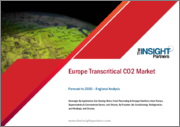
|
시장보고서
상품코드
1521202
세계의 초임계 CO2 시장 보고서 : 기능별, 용도별, 지역별(2024-2032년)Transcritical Co2 Market Report by Function (Refrigeration, Heating, Air Conditioning), Application (Supermarkets and Convenience Stores, Ice Skating Rinks, Food Processing and Storage Facilities, Heat Pumps, and Others), and Region 2024-2032 |
||||||
세계 초임계 CO2 시장 규모는 2023년 522억 달러에 달했습니다. 향후 IMARC 그룹은 2032년까지 시장 규모가 1,958억 달러에 달하고, 2024년부터 2032년까지 15.5%의 연평균 성장률(CAGR)을 나타낼 것으로 예측했습니다. 냉장 용도의 다양한 소매 시설에서 광범위한 견인력, 자동차 초임계 CO2 기술의 지속적인 발전, 초임계 CO2의 다양한 이점에 대한 소비자의 인식 증가는 시장을 이끄는 주요 요인 중 일부입니다.
초임계 CO2는 이산화탄소(CO2)의 온도와 압력이 임계점을 넘어선 상태를 말하며, CO2는 특히 냉동, 난방 및 발전 시스템과 같은 다양한 응용 분야에서 환경 친화적이고 다재다능한 작동 유체가 되는 독특한 특성을 가지고 있습니다. 초임계 CO2 시스템에서 CO2는 아임계 및 초임계 단계를 모두 포함하는 사이클에서 작동하여 효율적인 열 전달 및 에너지 교환을 가능하게 합니다. 초임계 CO2 시스템의 가장 큰 장점은 높은 에너지 효율과 환경 부하 감소를 기대할 수 있다는 점입니다. 지구온난화지수와 오존층 파괴계수가 낮아 기후 변화 완화에 기여하는 등 기존 냉매를 대체할 수 있는 냉매로 주목받고 있습니다.
세계 시장의 주요 원동력은 낮은 유지보수 필요성, 향상된 에너지 효율성, 경제성으로 인해 다양한 소매 시설에서 냉장 용도로 널리 보급되고 있다는 점입니다. 이러한 추세는 식품 가공 및 상업용 냉장 시설에 이러한 시스템이 널리 채택되면서 더욱 확대되고 있습니다. 이는 제품의 신선도 유지와 유통기한 연장이라는 두 가지 목적을 달성하기 위한 것으로, 시장 성장에 크게 기여하고 있습니다. 또한, 공조, 건물 난방, 급탕용 고객 서비스 및 주택 분야에서 수요 증가도 시장 성장에 기여하고 있습니다. 또한, 자동차 초임계 CO2 기술의 발전도 시장 확대에 새로운 국면을 맞이하고 있습니다. 이 기술은 자동차 실내 온도 제어, 배터리 팩 온도 조절, 모터 및 전기 부품 냉각 등 자동차의 열 관리 요구를 충족시킬 수 있는 능력을 갖추고 있어 긍정적인 영향을 미치고 있습니다. 또한 초임계 CO2 시스템의 다양한 이점에 대한 소비자의 인식 증가, 지구 온난화에 대한 우려 증가, 마가린 제조, 맥주 양조 및 제빙과 같은 산업에서의 광범위한 채택이 시장의 상승 궤도를 주도하고 있습니다.
초임계 CO2 시장 동향/촉진요인 :
환경 규제 및 지속가능성 노력
기후 변화와 그 광범위한 영향에 대한 전 세계의 우려가 커지면서 각국 정부와 국제기구는 온실가스 배출을 억제하기 위해 더욱 적극적인 자세를 취하고 있으며, CO2 초임계압 시스템은 환경적 이점으로 인해 큰 주목을 받고 있습니다. 파괴하지 않습니다. 산업계가 더욱 엄격한 배출 목표와 규제 의무에 직면하고 있는 가운데 초임계 CO2는 이러한 목표에 부합하는 매력적인 솔루션을 제공합니다. 초임계 CO2 시스템을 채택함으로써 산업계는 규제 요건을 충족시킬 뿐만 아니라 지속 가능한 관행과 책임감 있는 자원 관리에 대한 약속을 보여줄 수 있습니다. 기후 변화 완화의 시급성은 초임계 CO2 시스템에 대한 필수적인 감각을 심어주어 상업용 냉장, 공조, 히트펌프 등 다양한 용도에 적합한 옵션으로 변화하고 있습니다.
에너지 효율 및 운영 비용 절감
에너지 비용이 치솟고 환경에 대한 인식이 높아지면서 모든 분야의 기업들이 운영 비용을 최소화하면서 에너지 소비를 최적화할 수 있는 방법을 적극적으로 모색하고 있습니다. 이러한 상황에서 초임계 CO2 시스템은 매력적인 가치 제안을 제공합니다. 초임계 CO2는 광범위한 온도 범위에서 효율을 유지하여 안정적이고 신뢰할 수 있는 작동을 보장합니다. 이러한 특성은 장기적으로 상당한 에너지 절감과 탄소 발자국 감소로 이어집니다. 슈퍼마켓, 식품 가공 시설, 제약 회사 등 집중적인 냉각 및 냉동이 필요한 산업은 초임계 CO2 시스템을 채택함으로써 큰 이점을 얻을 수 있습니다. 에너지 소비를 줄이면 수익에 직접적인 영향을 미쳐 수익성을 개선하는 동시에 환경 및 지속가능성 목표에도 부합합니다.
지속적인 기술 진보와 혁신
연구자, 엔지니어, 제조업체들은 초임계 CO2 기술의 한계를 극복하고 새로운 가능성을 열기 위해 공동으로 도전하고 있습니다. 압축기는 모든 냉동 시스템의 핵심이며, 초임계 CO2에 최적화된 설계가 개발되고 있습니다. 이러한 발전은 효율성, 내구성, 신뢰성을 향상시키고 전체 시스템 성능에 기여하는 데 초점을 맞추었습니다. 또한 초임계 CO2 시스템에서 효율적인 열 전달을 촉진하고 원활한 작동과 향상된 에너지 활용을 보장하기 위해 새로운 열교환기 설계가 연구되고 있습니다. 시스템 제어 및 최적화 알고리즘 또한 초임계 CO2 시스템의 이점을 극대화하는 데 매우 중요한 역할을 합니다. 이러한 시스템에는 복잡한 열역학 및 유체 역학이 관련되어 있기 때문에 다양한 작동 조건과 부하에 적응할 수 있는 고급 제어 전략이 개발되고 있습니다.
목차
제1장 서문
제2장 조사 범위와 조사 방법
- 조사 목적
- 이해관계자
- 데이터 소스
- 1차 정보
- 2차 정보
- 시장 추정
- 보텀업 접근
- 톱다운 접근
- 조사 방법
제3장 주요 요약
제4장 서론
- 개요
- 주요 업계 동향
제5장 세계의 초임계 CO2 시장
- 시장 개요
- 시장 실적
- COVID-19의 영향
- 시장 예측
제6장 시장 분석 : 기능별
- 냉동
- 시장 동향
- 시장 예측
- 난방
- 시장 동향
- 시장 예측
- 공조
- 시장 동향
- 시장 예측
제7장 시장 분석 : 용도별
- 슈퍼마켓 및 편의점
- 시장 동향
- 시장 예측
- 스케이트 링크
- 시장 동향
- 시장 예측
- 식품 가공 및 보관 시설
- 시장 동향
- 시장 예측
- 히트펌프
- 시장 동향
- 시장 예측
- 기타
- 시장 동향
- 시장 예측
제8장 시장 분석 : 지역별
- 북미
- 미국
- 캐나다
- 아시아태평양
- 중국
- 일본
- 인도
- 한국
- 호주
- 인도네시아
- 기타
- 유럽
- 독일
- 프랑스
- 영국
- 이탈리아
- 스페인
- 러시아
- 기타
- 라틴아메리카
- 브라질
- 멕시코
- 기타
- 중동 및 아프리카
- 시장 동향
- 시장 분석 : 국가별
- 시장 예측
제9장 SWOT 분석
- 개요
- 강점
- 약점
- 기회
- 위협
제10장 밸류체인 분석
제11장 Porter의 Five Forces 분석
- 개요
- 바이어의 교섭력
- 공급 기업의 교섭력
- 경쟁 정도
- 신규 진출업체의 위협
- 대체품의 위협
제12장 가격 분석
제13장 경쟁 구도
- 시장 구조
- 주요 기업
- 주요 기업 개요
- Baltimore Aircoil Company Inc.(AMSTED Industries Incorporated)
- Bitzer SE
- Carnot Refrigeration(M&M Refrigeration)
- Carrier Global Corporation
- Danfoss
- Dorin S.p.A.
- Emerson Electric Co.
- Hill Phoenix Inc.(Dover Corporation)
- Mayekawa Mfg. Co. Ltd.
- Panasonic Holdings Corporation
- SCM Frigo S.p.A.
The global transcritical CO2 market size reached US$ 52.2 Billion in 2023. Looking forward, IMARC Group expects the market to reach US$ 195.8 Billion by 2032, exhibiting a growth rate (CAGR) of 15.5% during 2024-2032. The extensive traction within diverse retail establishments for refrigeration applications, continual advancements in automotive transcritical CO2 technology, and increasing consumer awareness regarding the manifold advantages of transcritical CO2 are some of the major factors propelling the market.
Transcritical CO2 is a state of carbon dioxide (CO2) where its temperature and pressure exceed the critical point. CO2 exhibits unique properties that make it an environmentally friendly and versatile working fluid in various applications, particularly in refrigeration, heating, and power generation systems. In transcritical CO2 systems, CO2 operates in a cycle that involves both subcritical and supercritical phases, which allows for efficient heat transfer and energy exchange. One of the most notable advantages of transcritical CO2 systems is their potential for high energy efficiency and reduced environmental impact. They have gained attention as an alternative to conventional refrigerants due to their low global warming potential and ozone depletion potential, contributing to the mitigation of climate change.
The global market is primarily driven by the extensive traction within diverse retail establishments for refrigeration applications, due to its low maintenance demands, energy efficiency enhancements, and economic attributes. This trend is further amplified by the widespread adoption of these systems in food processing and commercial cold storage facilities. These adoptions serve the dual purpose of preserving product freshness and extending shelf life, contributing significantly to the market growth. Moreover, the market is supported by the escalating demands in the hospitality and residential sectors for air conditioning, building heating, and hot water supply applications. Also, advancements in automotive transcritical CO2 technology have added a new dimension to market expansion. This technology's ability to fulfill a vehicle's thermal management needs, encompassing passenger compartment temperature control, battery pack temperature regulation, and cooling of motor and electrical components, has left a positive impact. Furthermore, the market's upward trajectory is propelled by increasing consumer awareness regarding the manifold advantages of transcritical CO2 systems, growing concerns about global warming, and their wide-ranging adoption in industries such as margarine production, beer brewing, and ice-making.
Transcritical CO2 Market Trends/Drivers:
Environmental Regulations and Sustainability Initiatives
With the rising global concern over climate change and its far-reaching impacts, governments and international bodies have taken a more assertive stance on curbing greenhouse gas emissions. Transcritical CO2 systems have garnered substantial attention due to their environmental benefits. They have a remarkably low GWP and is non-ozone depleting. As industries confront stricter emission targets and regulatory mandates, transcritical CO2 offers a compelling solution that aligns with these goals. By adopting transcritical CO2 systems, industries not only meet regulatory requirements but also demonstrate their commitment to sustainable practices and responsible resource management. The urgency of climate change mitigation has imbued transcritical CO2 systems with a sense of imperative, transforming them into a preferred choice for various applications such as commercial refrigeration, air conditioning, and heat pumps.
Energy Efficiency and Operational Cost Savings
With escalating energy costs and heightened environmental consciousness, businesses across sectors are actively seeking ways to optimize their energy consumption while minimizing operational expenses. Transcritical CO2 systems offer an attractive value proposition in this context. Transcritical CO2 maintains its efficiency across a wide range of temperatures, ensuring consistent and reliable operation. This characteristic translates to substantial energy savings over the long term, as well as reduced carbon footprints. Industries that require intensive cooling and refrigeration, such as supermarkets, food processing facilities, and pharmaceutical companies, stand to benefit significantly from the adoption of transcritical CO2 systems. The reduced energy consumption directly impacts their bottom line, improving profitability while simultaneously aligning with their environmental and sustainability goals.
Continuous Technological Advancements and Innovation
Researchers, engineers, and manufacturers are collaboratively pushing the boundaries of transcritical CO2 technology to address challenges and unlock new possibilities. Compressors are at the heart of any refrigeration system, and tailored designs optimized for transcritical CO2 are being developed. These advancements focus on enhancing efficiency, durability, and reliability, thereby contributing to the overall system performance. Moreover, novel heat exchanger designs are being explored to facilitate efficient heat transfer in transcritical CO2 systems, ensuring seamless operation and improved energy utilization. System controls and optimization algorithms also play a pivotal role in maximizing the benefits of transcritical CO2 systems. As these systems involve complex thermodynamics and fluid dynamics, sophisticated control strategies are being developed to adapt to varying operating conditions and loads.
Transcritical CO2 Industry Segmentation:
IMARC Group provides an analysis of the key trends in each segment of the global transcritical CO2 market report, along with forecasts at the global, regional and country levels from 2024-2032. Our report has categorized the market based on function and application.
Breakup by Function:
Refrigeration
Heating
Air Conditioning
Refrigeration holds the largest share in the market
A detailed breakup and analysis of the market based on the function has also been provided in the report. This includes refrigeration, heating, and air conditioning. According to the report, refrigeration accounted for the largest market share.
Refrigeration systems are integral to a wide range of industries, including food and beverage, retail, pharmaceuticals, and logistics, making them essential components of global supply chains and daily life. Transcritical CO2 systems have gained considerable traction in the refrigeration sector due to their exceptional efficiency, environmental benefits, and adaptability to varying operating conditions. In the food and beverage industry, where precise temperature control and preservation of perishable goods are paramount, transcritical CO2 refrigeration systems offer a distinct advantage. These systems maintain consistent cooling even in high-temperature environments, ensuring food safety, extending shelf life, and minimizing waste. Moreover, the pharmaceutical and healthcare sectors benefit immensely from transcritical CO2 refrigeration systems. These industries require strict temperature control for storing and transporting sensitive medical supplies, vaccines, and medications. Additionally, the logistics and cold storage industry relies heavily on refrigeration to maintain the quality of goods during transportation and storage.
Breakup by Application:
Supermarkets and Convenience Stores
Ice Skating Rinks
Food Processing and Storage Facilities
Heat Pumps
Others
Supermarkets and convenience stores hold the largest share in the market
A detailed breakup and analysis of the market based on the application has also been provided in the report. This includes supermarkets and convenience stores, ice Skating rinks, food processing and storage facilities, heat pumps, and others. According to the report, supermarkets and convenience stores accounted for the largest market share.
Supermarkets and convenience stores have a substantial energy footprint attributed to their 24/7 operations, extensive refrigeration needs, and temperature-controlled environments for perishable goods. Transcritical CO2 systems offer a transformative solution to these challenges, addressing energy efficiency, environmental concerns, and economic considerations. Transcritical CO2 technology's ability to operate efficiently across a wide range of temperatures, including high ambient conditions, resonates profoundly with the needs of supermarkets and convenience stores. Transcritical CO2 systems maintain consistent performance, ensuring reliable and cost-effective cooling even in demanding climates. This consistency directly translates to reduced energy bills, a crucial factor for retail businesses focussing to optimize profitability. Furthermore, the eco-friendly attributes resonate with consumers increasingly seeking environmentally responsible shopping experiences. By adopting transcritical CO2 technology, supermarkets and convenience stores showcase their commitment to sustainability, responding to consumer expectations for greener alternatives and reduced carbon footprints.
Breakup by Region:
North America
United States
Canada
Asia-Pacific
China
Japan
India
South Korea
Australia
Indonesia
Others
Europe
Germany
France
United Kingdom
Italy
Spain
Russia
Others
Latin America
Brazil
Mexico
Others
Middle East and Africa
Europe exhibits a clear dominance, accounting for the largest transcritical CO2 market share
The report has also provided a comprehensive analysis of all the major regional markets, which include North America (the United States and Canada), Asia Pacific (China, Japan, India, South Korea, Australia, Indonesia, and others), Europe (Germany, France, the United Kingdom, Italy, Spain, Russia, and others), Latin America (Brazil, Mexico, and others), and the Middle East and Africa. According to the report, Europe accounted for the largest market share.
Europe's commitment to environmental preservation and sustainable practices aligns seamlessly with the inherent benefits of transcritical CO2 systems. As the region endeavors to mitigate the impacts of climate change, CO2's low global warming potential (GWP) and zero ozone depletion potential (ODP) make it an appealing choice for industries looking to transition away from conventional high-GWP refrigerants. Moreover, stringent regulatory frameworks play a pivotal role in augmenting the adoption of transcritical CO2 systems. This legislation imposes limitations on the use of fluorinated gases, including HFCs, within the region. This regulatory environment has prompted businesses to explore sustainable alternatives, such as transcritical CO2, which not only meets compliance requirements but also aligns with the ethos of responsible production and consumption. Furthermore, Europe's diverse industrial landscape, spanning from retail and food sectors to industrial and commercial applications, provides a broad canvas for the deployment of transcritical CO2 technology.
Competitive Landscape:
Companies in the transcritical CO2 market are actively engaged in a multifaceted range of activities aimed at advancing the adoption, innovation, and optimization of transcritical CO2 technology across various industries. Major players in the field, including multinational corporations and innovative startups are heavily investing significantly in research and development efforts. These endeavors focus on refining the efficiency, reliability, and safety of transcritical CO2 systems. R&D initiatives encompass the development of advanced compressor technologies, heat exchangers, and system controls that are tailored to the unique thermodynamic properties of CO2 in transcritical conditions. Companies are also focussing to enhance the scalability and applicability of transcritical CO2 solutions. They are collaborating with different sectors, such as commercial refrigeration, industrial processes, and heating applications, to design systems that cater to a wider array of operational needs. This involves engineering adaptable configurations that can efficiently manage diverse temperature requirements and operational loads.
The report has provided a comprehensive analysis of the competitive landscape in the market. Detailed profiles of all major companies have also been provided. Some of the key players in the market include:
Baltimore Aircoil Company Inc. (AMSTED Industries Incorporated)
Bitzer SE
Carnot Refrigeration (M&M Refrigeration)
Carrier Global Corporation
Danfoss
Dorin S.p.A.
Emerson Electric Co.
Hill Phoenix Inc. (Dover Corporation)
Mayekawa Mfg. Co. Ltd.
Panasonic Holdings Corporation
SCM Frigo S.p.A.
Recent Developments:
In August 2023, SCM Frigo S.p.A. launched higher capacity transcritical CO2, "smart booster 2.0" racks for commercial applications. It offers a new configuration with a total of five compressors to provide a higher cooling capacity for both low and medium temperatures.
In March 2023, Emerson Electric Co launched new transcritical CO2 screw compressor unit. The new transcritical CO2 compressor utilizes established single-screw compression with an all-inclusive design, integrating controller, suction valve, inverter motor, and oil management, while maintaining adaptable scalability and using a consistent oil system and controller.
In June 2022, Carrier Global Corporation launched new energy efficient versatile EasyCube solution for chilled or frozen products. It is a highly energy-efficient plug-in island cabinet with the versatility to switch between chilled or frozen refrigeration and offer outstanding product visibility.
Key Questions Answered in This Report
- 1. How big is the global transcritical CO2 market?
- 2. What is the expected growth rate of the global transcritical CO2 market during 2024-2032?
- 3. What are the key factors driving the global transcritical CO2 market?
- 4. What has been the impact of COVID-19 on the global transcritical CO2 market?
- 5. What is the breakup of the global transcritical CO2 market based on the function?
- 6. What is the breakup of the global transcritical CO2 market based on the application?
- 7. What are the key regions in the global transcritical CO2 market?
- 8. Who are the key players/companies in the global transcritical CO2 market?
Table of Contents
1 Preface
2 Scope and Methodology
- 2.1 Objectives of the Study
- 2.2 Stakeholders
- 2.3 Data Sources
- 2.3.1 Primary Sources
- 2.3.2 Secondary Sources
- 2.4 Market Estimation
- 2.4.1 Bottom-Up Approach
- 2.4.2 Top-Down Approach
- 2.5 Forecasting Methodology
3 Executive Summary
4 Introduction
- 4.1 Overview
- 4.2 Key Industry Trends
5 Global Transcritical CO2 Market
- 5.1 Market Overview
- 5.2 Market Performance
- 5.3 Impact of COVID-19
- 5.4 Market Forecast
6 Market Breakup by Function
- 6.1 Refrigeration
- 6.1.1 Market Trends
- 6.1.2 Market Forecast
- 6.2 Heating
- 6.2.1 Market Trends
- 6.2.2 Market Forecast
- 6.3 Air Conditioning
- 6.3.1 Market Trends
- 6.3.2 Market Forecast
7 Market Breakup by Application
- 7.1 Supermarkets and Convenience Stores
- 7.1.1 Market Trends
- 7.1.2 Market Forecast
- 7.2 Ice Skating Rinks
- 7.2.1 Market Trends
- 7.2.2 Market Forecast
- 7.3 Food Processing and Storage Facilities
- 7.3.1 Market Trends
- 7.3.2 Market Forecast
- 7.4 Heat Pumps
- 7.4.1 Market Trends
- 7.4.2 Market Forecast
- 7.5 Others
- 7.5.1 Market Trends
- 7.5.2 Market Forecast
8 Market Breakup by Region
- 8.1 North America
- 8.1.1 United States
- 8.1.1.1 Market Trends
- 8.1.1.2 Market Forecast
- 8.1.2 Canada
- 8.1.2.1 Market Trends
- 8.1.2.2 Market Forecast
- 8.1.1 United States
- 8.2 Asia-Pacific
- 8.2.1 China
- 8.2.1.1 Market Trends
- 8.2.1.2 Market Forecast
- 8.2.2 Japan
- 8.2.2.1 Market Trends
- 8.2.2.2 Market Forecast
- 8.2.3 India
- 8.2.3.1 Market Trends
- 8.2.3.2 Market Forecast
- 8.2.4 South Korea
- 8.2.4.1 Market Trends
- 8.2.4.2 Market Forecast
- 8.2.5 Australia
- 8.2.5.1 Market Trends
- 8.2.5.2 Market Forecast
- 8.2.6 Indonesia
- 8.2.6.1 Market Trends
- 8.2.6.2 Market Forecast
- 8.2.7 Others
- 8.2.7.1 Market Trends
- 8.2.7.2 Market Forecast
- 8.2.1 China
- 8.3 Europe
- 8.3.1 Germany
- 8.3.1.1 Market Trends
- 8.3.1.2 Market Forecast
- 8.3.2 France
- 8.3.2.1 Market Trends
- 8.3.2.2 Market Forecast
- 8.3.3 United Kingdom
- 8.3.3.1 Market Trends
- 8.3.3.2 Market Forecast
- 8.3.4 Italy
- 8.3.4.1 Market Trends
- 8.3.4.2 Market Forecast
- 8.3.5 Spain
- 8.3.5.1 Market Trends
- 8.3.5.2 Market Forecast
- 8.3.6 Russia
- 8.3.6.1 Market Trends
- 8.3.6.2 Market Forecast
- 8.3.7 Others
- 8.3.7.1 Market Trends
- 8.3.7.2 Market Forecast
- 8.3.1 Germany
- 8.4 Latin America
- 8.4.1 Brazil
- 8.4.1.1 Market Trends
- 8.4.1.2 Market Forecast
- 8.4.2 Mexico
- 8.4.2.1 Market Trends
- 8.4.2.2 Market Forecast
- 8.4.3 Others
- 8.4.3.1 Market Trends
- 8.4.3.2 Market Forecast
- 8.4.1 Brazil
- 8.5 Middle East and Africa
- 8.5.1 Market Trends
- 8.5.2 Market Breakup by Country
- 8.5.3 Market Forecast
9 SWOT Analysis
- 9.1 Overview
- 9.2 Strengths
- 9.3 Weaknesses
- 9.4 Opportunities
- 9.5 Threats
10 Value Chain Analysis
11 Porters Five Forces Analysis
- 11.1 Overview
- 11.2 Bargaining Power of Buyers
- 11.3 Bargaining Power of Suppliers
- 11.4 Degree of Competition
- 11.5 Threat of New Entrants
- 11.6 Threat of Substitutes
12 Price Analysis
13 Competitive Landscape
- 13.1 Market Structure
- 13.2 Key Players
- 13.3 Profiles of Key Players
- 13.3.1 Baltimore Aircoil Company Inc. (AMSTED Industries Incorporated)
- 13.3.1.1 Company Overview
- 13.3.1.2 Product Portfolio
- 13.3.2 Bitzer SE
- 13.3.2.1 Company Overview
- 13.3.2.2 Product Portfolio
- 13.3.3 Carnot Refrigeration (M&M Refrigeration)
- 13.3.3.1 Company Overview
- 13.3.3.2 Product Portfolio
- 13.3.4 Carrier Global Corporation
- 13.3.4.1 Company Overview
- 13.3.4.2 Product Portfolio
- 13.3.4.3 Financials
- 13.3.5 Danfoss
- 13.3.5.1 Company Overview
- 13.3.5.2 Product Portfolio
- 13.3.5.3 SWOT Analysis
- 13.3.6 Dorin S.p.A.
- 13.3.6.1 Company Overview
- 13.3.6.2 Product Portfolio
- 13.3.7 Emerson Electric Co.
- 13.3.7.1 Company Overview
- 13.3.7.2 Product Portfolio
- 13.3.7.3 Financials
- 13.3.8 Hill Phoenix Inc. (Dover Corporation)
- 13.3.8.1 Company Overview
- 13.3.8.2 Product Portfolio
- 13.3.9 Mayekawa Mfg. Co. Ltd.
- 13.3.9.1 Company Overview
- 13.3.9.2 Product Portfolio
- 13.3.10 Panasonic Holdings Corporation
- 13.3.10.1 Company Overview
- 13.3.10.2 Product Portfolio
- 13.3.10.3 Financials
- 13.3.10.4 SWOT Analysis
- 13.3.11 SCM Frigo S.p.A.
- 13.3.11.1 Company Overview
- 13.3.11.2 Product Portfolio
- 13.3.1 Baltimore Aircoil Company Inc. (AMSTED Industries Incorporated)



















